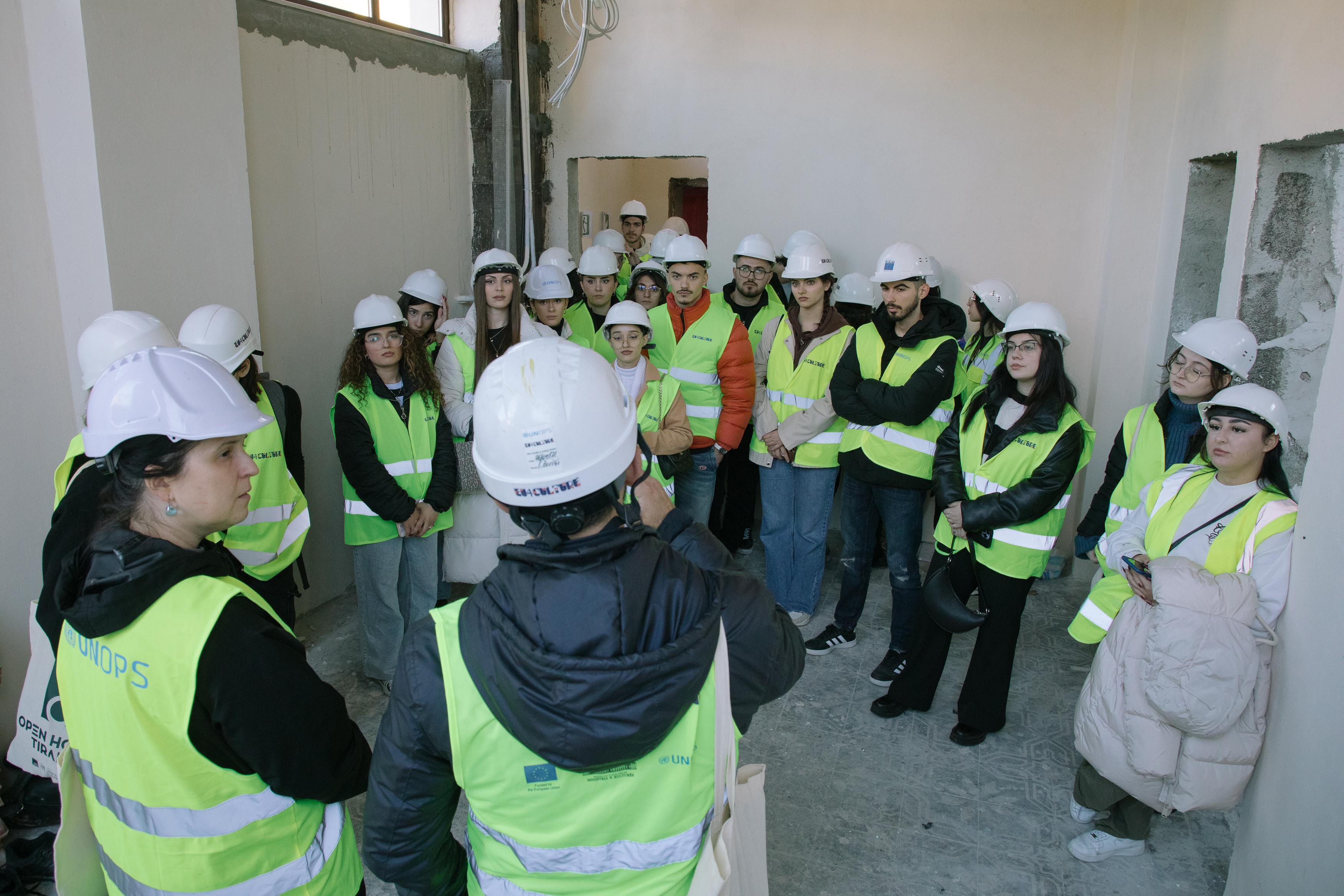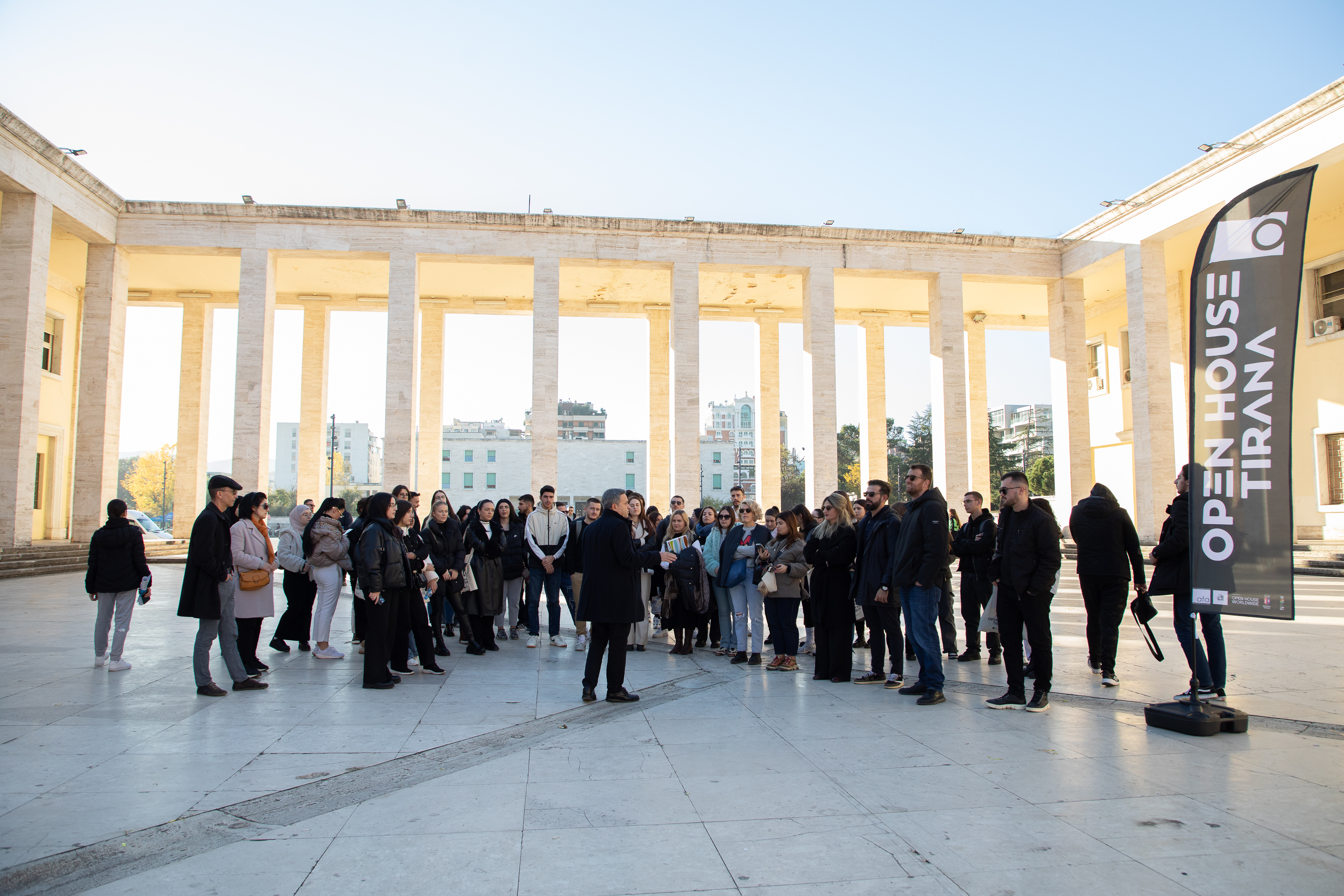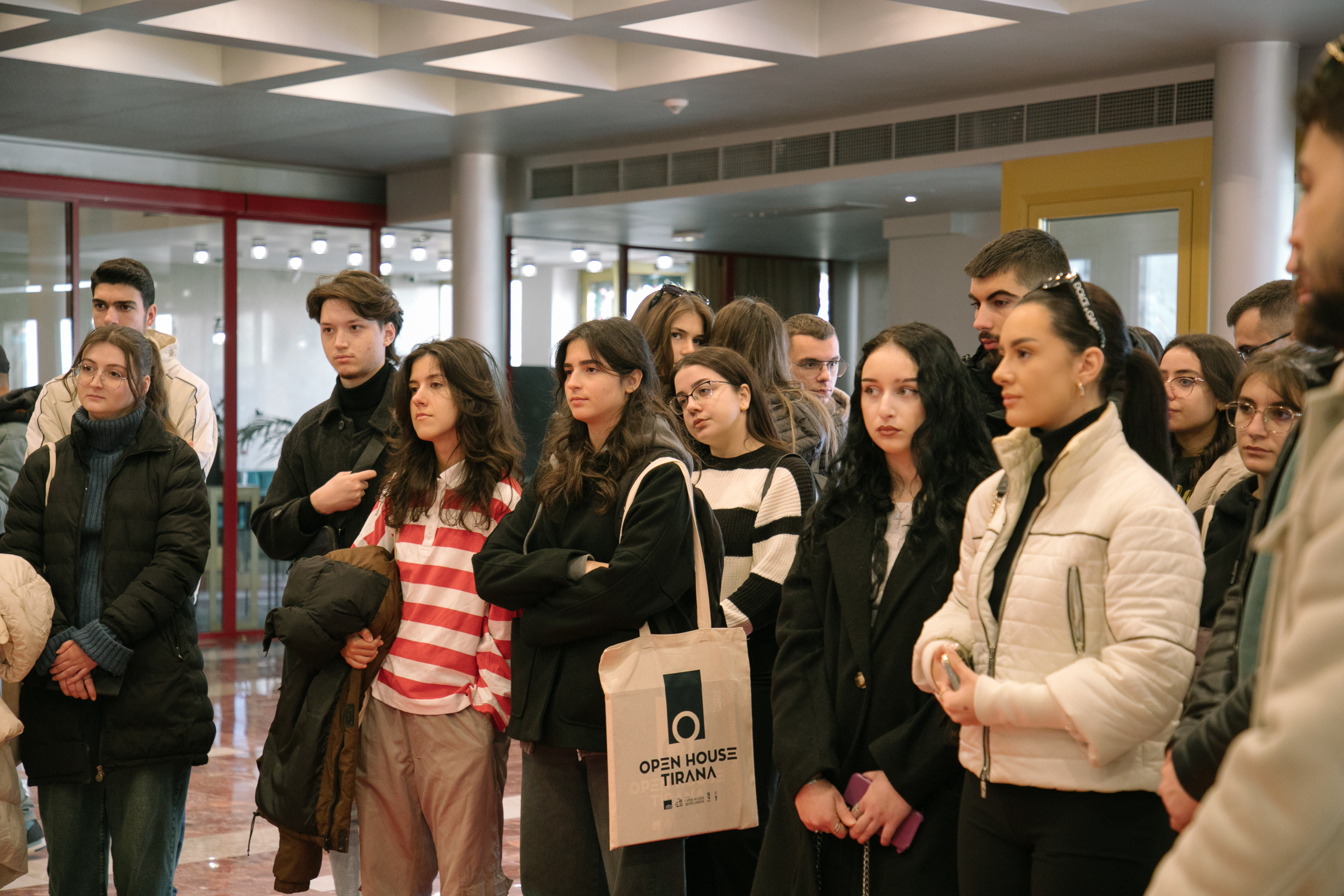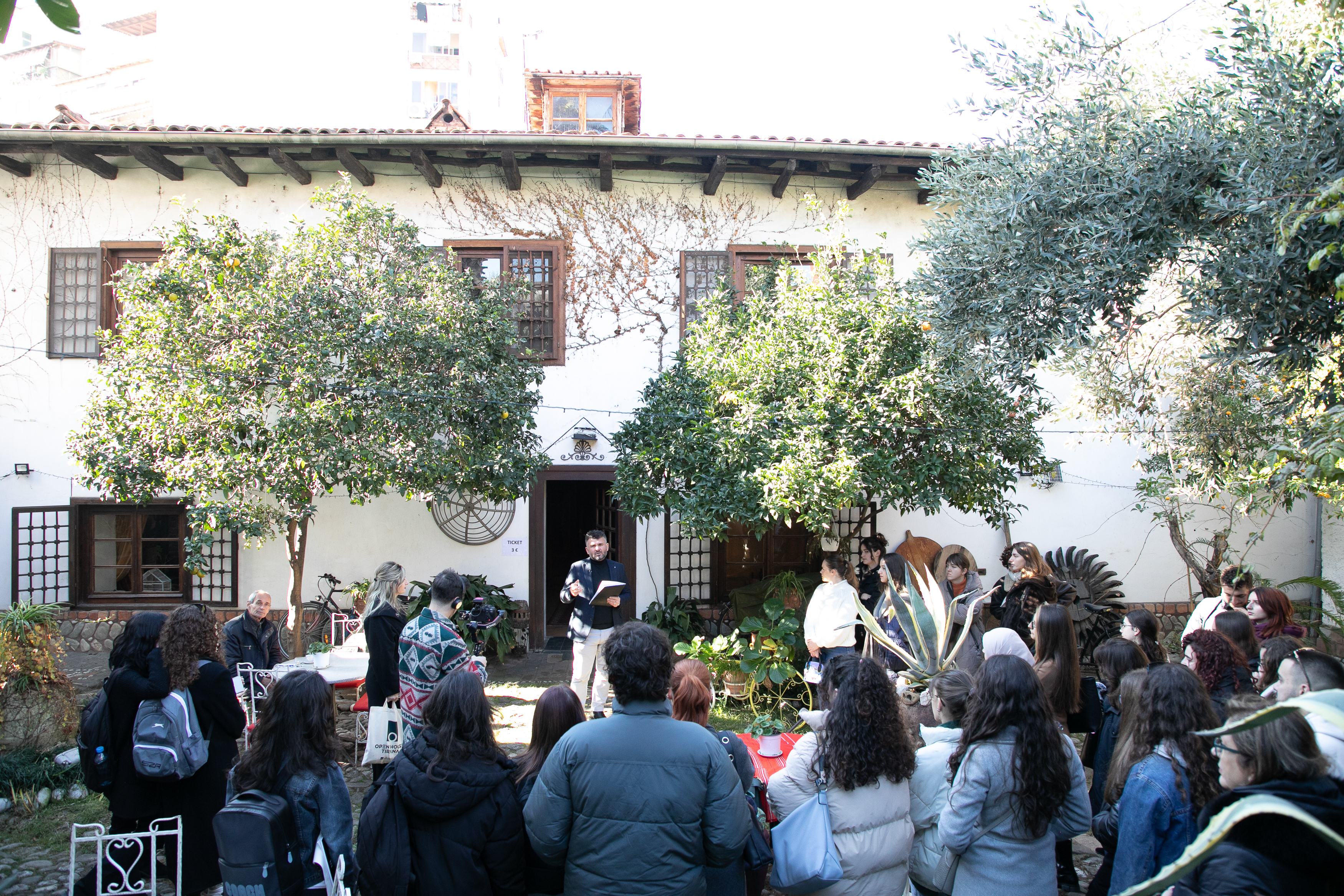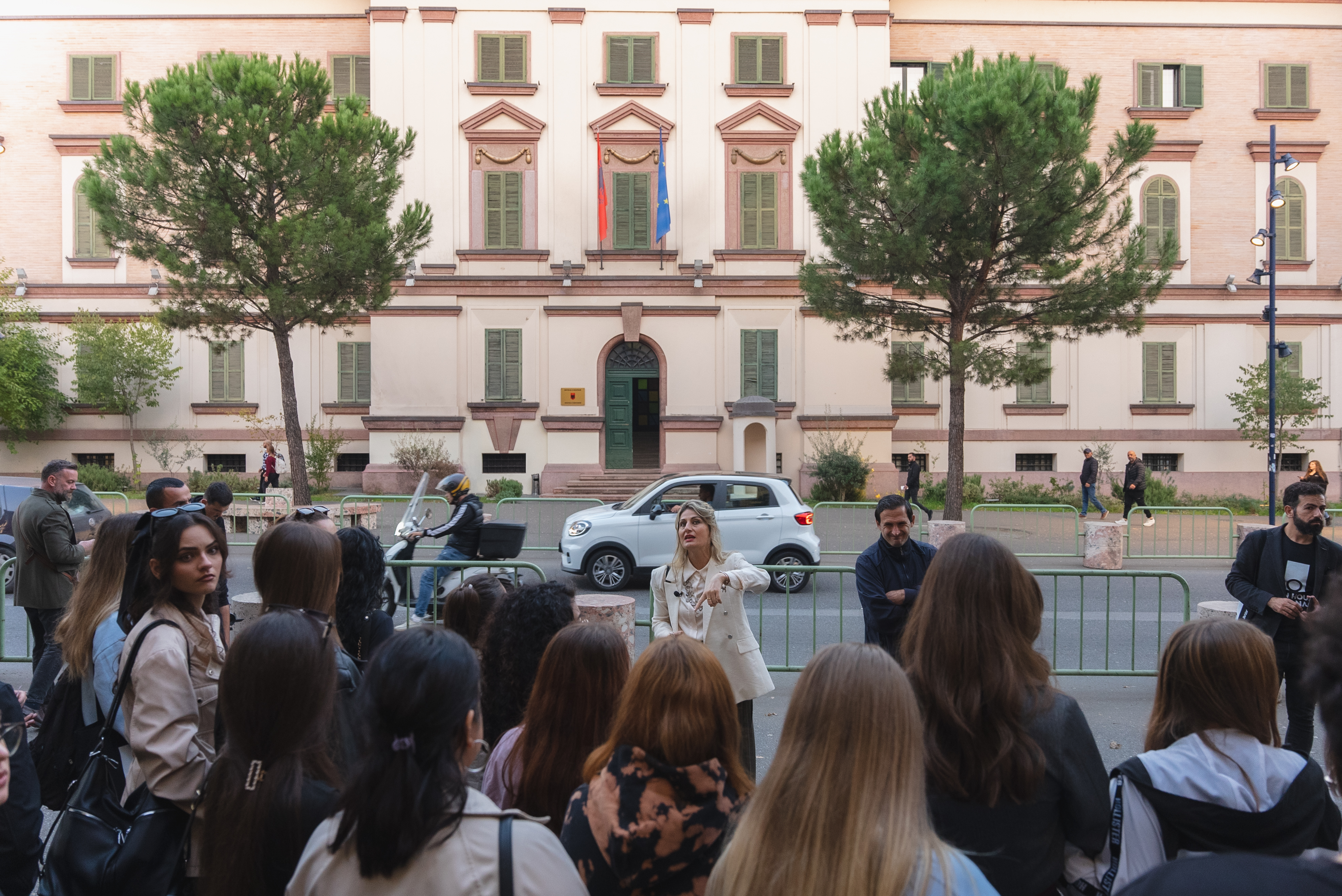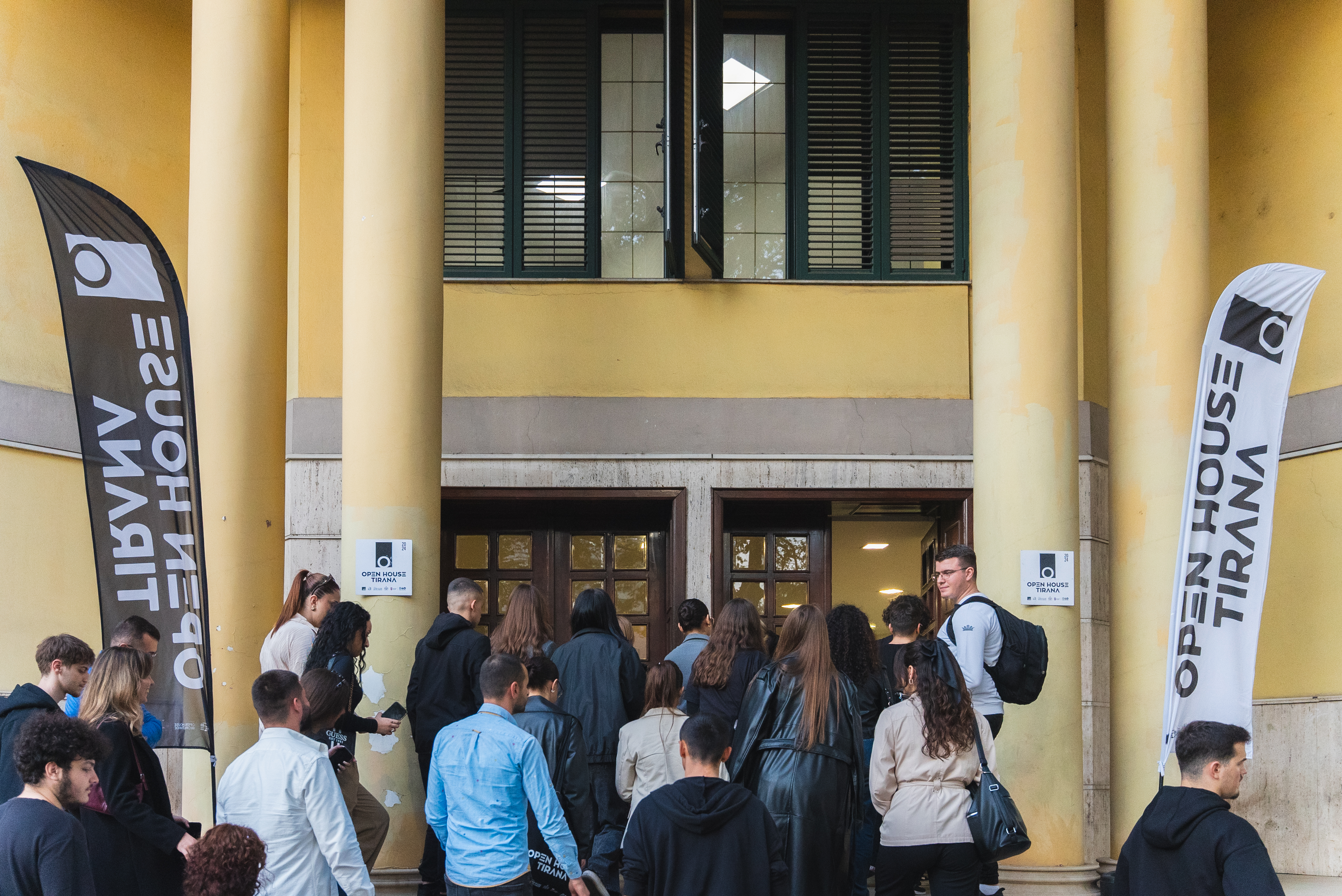Regaining a sense of belonging
Open House Tirana Festival
Open House Tirana: Rediscovering Belonging Through Collective Memory
Open House Tirana is it’s a movement embodying the New European Bauhaus values by reconnecting people with the spaces that shape their daily lives. By opening doors to iconic and overlooked architecture, we invite the public to experience the city in new ways, fostering dialogue, inclusivity, and cultural identity. Through guided tours, visual storytelling, and participatory events, we celebrate heritage, urban regeneration, and contemporary design, making architecture accessible to all.
Albania
Local
Tirana
It addresses urban-rural linkages
It refers to a physical transformation of the built environment (hard investment)
Yes
2024-10-28
No
No
No
As a representative of an organisation, in partnership with other organisations
Open House Tirana: Rediscovering Belonging Through Collective Memory
Overall Aim:
Open House Tirana fosters a deeper connection between people and their built environment, transforming the city into an open museum where architecture becomes a tool for community engagement, education, and cultural dialogue.
Target Groups:
Citizens of all ages, students, architects, urban planners, cultural enthusiasts, and marginalized communities.
Specific Objectives:
Strengthen the public’s sense of belonging by opening access to architectural and cultural heritage.
Promote inclusive urban narratives through guided tours, visual storytelling, and participatory events.
Bridge past and future by showcasing urban regeneration, adaptive reuse, and contemporary architecture.
Achieved Outcomes:
Thousands of citizens engaged in exploring their city through interactive experiences.
Enhanced cultural awareness and local identity.
Strengthened community ties and cross-sector collaborations in urban development.
Alignment with New
Overall Aim:
Open House Tirana fosters a deeper connection between people and their built environment, transforming the city into an open museum where architecture becomes a tool for community engagement, education, and cultural dialogue.
Target Groups:
Citizens of all ages, students, architects, urban planners, cultural enthusiasts, and marginalized communities.
Specific Objectives:
Strengthen the public’s sense of belonging by opening access to architectural and cultural heritage.
Promote inclusive urban narratives through guided tours, visual storytelling, and participatory events.
Bridge past and future by showcasing urban regeneration, adaptive reuse, and contemporary architecture.
Achieved Outcomes:
Thousands of citizens engaged in exploring their city through interactive experiences.
Enhanced cultural awareness and local identity.
Strengthened community ties and cross-sector collaborations in urban development.
Alignment with New
Heritage Preservation
Community Engagement
Urban Identity
Participatory Architecture
Cultural Sustainability
Sustainability in Open House Tirana: Fostering Collective Memory for a Resilient Future
Open House Tirana integrates sustainability by promoting the adaptive reuse of heritage, raising awareness of sustainable urban development, and fostering a long-term commitment to preserving collective memory. The project ensures that architecture is not only valued as a cultural asset but also as a resource that can be reused and reimagined for future generations.
Key Objectives in Sustainability:
Adaptive Reuse & Heritage Conservation: Open House Tirana highlights architectural heritage as a sustainable asset, advocating for the rehabilitation and adaptive reuse of historic structures instead of demolition.
Public Awareness on Sustainable Urban Development: Through guided tours and discussions, the project educates citizens on the environmental impact of urbanization and the role of sustainable architecture in shaping the city.
Encouraging Low-Impact Cultural Participation: The festival operates with a minimal ecological footprint, using existing urban spaces as open classrooms, eliminating the need for large-scale interventions or resource-intensive installations.
Fostering Local Knowledge and Skills: The project connects experts, students, and local communities to exchange knowledge on sustainable building practices and urban preservation strategies.
Long-Term Community Engagement: By reinforcing a sense of belonging, Open House Tirana empowers communities to become active stakeholders in protecting and maintaining their built environment sustainably.
Exemplary Character:
The project serves as a model for how participatory urban experiences can promote sustainability by fostering appreciation for existing spaces, reducing wasteful urban renewal, and ensuring cultural heritage remains a living, functional part of the city’s future.
Open House Tirana integrates sustainability by promoting the adaptive reuse of heritage, raising awareness of sustainable urban development, and fostering a long-term commitment to preserving collective memory. The project ensures that architecture is not only valued as a cultural asset but also as a resource that can be reused and reimagined for future generations.
Key Objectives in Sustainability:
Adaptive Reuse & Heritage Conservation: Open House Tirana highlights architectural heritage as a sustainable asset, advocating for the rehabilitation and adaptive reuse of historic structures instead of demolition.
Public Awareness on Sustainable Urban Development: Through guided tours and discussions, the project educates citizens on the environmental impact of urbanization and the role of sustainable architecture in shaping the city.
Encouraging Low-Impact Cultural Participation: The festival operates with a minimal ecological footprint, using existing urban spaces as open classrooms, eliminating the need for large-scale interventions or resource-intensive installations.
Fostering Local Knowledge and Skills: The project connects experts, students, and local communities to exchange knowledge on sustainable building practices and urban preservation strategies.
Long-Term Community Engagement: By reinforcing a sense of belonging, Open House Tirana empowers communities to become active stakeholders in protecting and maintaining their built environment sustainably.
Exemplary Character:
The project serves as a model for how participatory urban experiences can promote sustainability by fostering appreciation for existing spaces, reducing wasteful urban renewal, and ensuring cultural heritage remains a living, functional part of the city’s future.
Aesthetics and Quality of Experience in Open House Tirana
Open House Tirana enhances the appreciation of architectural and urban aesthetics by offering immersive experiences that connect people with the city’s built environment. The project transforms architecture from a passive backdrop into an active cultural medium, fostering awareness of design quality, spatial identity, and the emotional impact of the built heritage.
Key Objectives in Aesthetics and Cultural Experience:
Revealing Architectural Beauty & Design Excellence: By opening doors to historical and contemporary buildings, Open House Tirana highlights the aesthetic value of urban spaces, from iconic landmarks to hidden architectural gems.
Curating Meaningful Cultural Narratives: The festival creates engaging storytelling experiences that bridge past and present, ensuring that design is not just seen but understood within historical and social contexts.
Encouraging Public Dialogue on Urban Quality: Guided tours, exhibitions, and discussions promote critical thinking about architectural quality, urban transformation, and the role of aesthetics in everyday life.
Interactive & Multisensory Experiences: Beyond visual appreciation, the program includes participatory workshops and storytelling formats that allow visitors to experience spaces through movement, sound, and tactile engagement.
Democratizing Access to Architectural Culture: By offering free, inclusive events, the festival makes high-quality design accessible to a broad audience, strengthening collective cultural appreciation.
Exemplary Character:
Open House Tirana sets an example for how architecture can be celebrated beyond professional circles, transforming urban exploration into a cultural event. By reconnecting people with their city’s design heritage, it fosters a lasting appreciation for aesthetics, urban quality, and the power of space to shape human experience.
Open House Tirana enhances the appreciation of architectural and urban aesthetics by offering immersive experiences that connect people with the city’s built environment. The project transforms architecture from a passive backdrop into an active cultural medium, fostering awareness of design quality, spatial identity, and the emotional impact of the built heritage.
Key Objectives in Aesthetics and Cultural Experience:
Revealing Architectural Beauty & Design Excellence: By opening doors to historical and contemporary buildings, Open House Tirana highlights the aesthetic value of urban spaces, from iconic landmarks to hidden architectural gems.
Curating Meaningful Cultural Narratives: The festival creates engaging storytelling experiences that bridge past and present, ensuring that design is not just seen but understood within historical and social contexts.
Encouraging Public Dialogue on Urban Quality: Guided tours, exhibitions, and discussions promote critical thinking about architectural quality, urban transformation, and the role of aesthetics in everyday life.
Interactive & Multisensory Experiences: Beyond visual appreciation, the program includes participatory workshops and storytelling formats that allow visitors to experience spaces through movement, sound, and tactile engagement.
Democratizing Access to Architectural Culture: By offering free, inclusive events, the festival makes high-quality design accessible to a broad audience, strengthening collective cultural appreciation.
Exemplary Character:
Open House Tirana sets an example for how architecture can be celebrated beyond professional circles, transforming urban exploration into a cultural event. By reconnecting people with their city’s design heritage, it fosters a lasting appreciation for aesthetics, urban quality, and the power of space to shape human experience.
Inclusion in Open House Tirana: Making Architecture Accessible to All
Open House Tirana is designed as an inclusive urban experience that democratizes access to architecture, ensuring that everyone—regardless of background, ability, or economic status—can engage with and contribute to the city’s built environment. The project fosters social cohesion by promoting diverse narratives, participatory experiences, and barrier-free access to architectural heritage and contemporary design.
Key Objectives in Inclusion:
Accessibility for All: The festival offers free access to all events, making architecture and urban culture available to a broad audience, including students, professionals, and marginalized communities.
Multilingual & Multimodal Engagement: To ensure broad participation, tours and discussions are conducted in multiple languages, and digital materials, including audio guides and visual aids, support different learning styles and accessibility needs.
Inclusive Storytelling & Representation: Open House Tirana highlights diverse architectural narratives, integrating perspectives from different social groups, including women, minorities, and underrepresented communities in urban development.
Design for All Principles: By engaging experts, students, and citizens in discussions on urban design, the project promotes inclusive planning approaches that prioritize accessibility in the built environment.
Community-Led Participation: Volunteers, local organizations, and institutions co-create the program, fostering a bottom-up governance model that values collective knowledge and shared responsibility in shaping the city.
Exemplary Character:
Open House Tirana serves as a model for inclusive cultural initiatives, demonstrating how architecture and urban heritage can be leveraged to strengthen community bonds, empower citizens, and promote a more accessible, participatory, and socially sustainable urban future.
Open House Tirana is designed as an inclusive urban experience that democratizes access to architecture, ensuring that everyone—regardless of background, ability, or economic status—can engage with and contribute to the city’s built environment. The project fosters social cohesion by promoting diverse narratives, participatory experiences, and barrier-free access to architectural heritage and contemporary design.
Key Objectives in Inclusion:
Accessibility for All: The festival offers free access to all events, making architecture and urban culture available to a broad audience, including students, professionals, and marginalized communities.
Multilingual & Multimodal Engagement: To ensure broad participation, tours and discussions are conducted in multiple languages, and digital materials, including audio guides and visual aids, support different learning styles and accessibility needs.
Inclusive Storytelling & Representation: Open House Tirana highlights diverse architectural narratives, integrating perspectives from different social groups, including women, minorities, and underrepresented communities in urban development.
Design for All Principles: By engaging experts, students, and citizens in discussions on urban design, the project promotes inclusive planning approaches that prioritize accessibility in the built environment.
Community-Led Participation: Volunteers, local organizations, and institutions co-create the program, fostering a bottom-up governance model that values collective knowledge and shared responsibility in shaping the city.
Exemplary Character:
Open House Tirana serves as a model for inclusive cultural initiatives, demonstrating how architecture and urban heritage can be leveraged to strengthen community bonds, empower citizens, and promote a more accessible, participatory, and socially sustainable urban future.
Citizen and Civil Society Involvement in Open House Tirana
Open House Tirana operates as a participatory platform where citizens and civil society play an active role in shaping and experiencing their city’s built environment. The project is rooted in the belief that architecture should be accessible to all and that urban spaces thrive when communities are engaged in their preservation, interpretation, and future development.
Citizen Involvement and Impact:
Co-Creation & Participatory Planning: The festival is co-designed with local communities, architects, students, and urban enthusiasts who contribute to curating tours, storytelling, and thematic discussions. This bottom-up approach ensures that the program reflects diverse perspectives and local knowledge.
Volunteer-Led Engagement: Hundreds of volunteers, including students, young professionals, and architecture enthusiasts, guide tours, moderate discussions, and document the festival. This hands-on involvement strengthens their connection with Tirana’s urban identity.
Public Dialogue & Civic Awareness: Open House Tirana provides a platform for citizens to voice their concerns, ideas, and aspirations about the future of their neighborhoods, fostering a culture of participatory urbanism.
Partnerships with Civil Society & Institutions: Collaborations with cultural organizations, educational institutions, and advocacy groups enrich the festival’s content, ensuring a multidimensional and inclusive experience.
Impact on the Project: The continuous engagement of civil society ensures that Open House Tirana remains responsive to the evolving needs of the city, strengthening its role as a bridge between professionals, policymakers, and the general public.
Exemplary Character:
By positioning citizens as co-creators rather than passive observers, Open House Tirana exemplifies how participatory urban experiences can drive cultural awareness, foster community resilience, and encourage long-term civic engagement.
Open House Tirana operates as a participatory platform where citizens and civil society play an active role in shaping and experiencing their city’s built environment. The project is rooted in the belief that architecture should be accessible to all and that urban spaces thrive when communities are engaged in their preservation, interpretation, and future development.
Citizen Involvement and Impact:
Co-Creation & Participatory Planning: The festival is co-designed with local communities, architects, students, and urban enthusiasts who contribute to curating tours, storytelling, and thematic discussions. This bottom-up approach ensures that the program reflects diverse perspectives and local knowledge.
Volunteer-Led Engagement: Hundreds of volunteers, including students, young professionals, and architecture enthusiasts, guide tours, moderate discussions, and document the festival. This hands-on involvement strengthens their connection with Tirana’s urban identity.
Public Dialogue & Civic Awareness: Open House Tirana provides a platform for citizens to voice their concerns, ideas, and aspirations about the future of their neighborhoods, fostering a culture of participatory urbanism.
Partnerships with Civil Society & Institutions: Collaborations with cultural organizations, educational institutions, and advocacy groups enrich the festival’s content, ensuring a multidimensional and inclusive experience.
Impact on the Project: The continuous engagement of civil society ensures that Open House Tirana remains responsive to the evolving needs of the city, strengthening its role as a bridge between professionals, policymakers, and the general public.
Exemplary Character:
By positioning citizens as co-creators rather than passive observers, Open House Tirana exemplifies how participatory urban experiences can drive cultural awareness, foster community resilience, and encourage long-term civic engagement.
Multilevel Stakeholder Engagement
OH Tirana is a collaborative initiative that brings together a diverse network of stakeholders at local, regional, national, and European levels. This multilevel engagement ensures that the festival is dynamic, impactful, and aligned with broader cultural and urban development strategies.
Local Level: Citizens & Community Groups: Residents actively participate by opening private spaces, sharing stories, and engaging in discussions about urban transformation, ensuring the festival reflects local identity and collective memory.
Architects & Urban Professionals: Local architects and planners guide tours, present projects, and contribute expertise to debates on heritage preservation and urban regeneration.
Universities & Educational Institutions: Barleti University and other academic partners involve students and faculty in curating events, providing research support, and fostering learning through participation.
Regional & National Level: Municipality of Tirana & Public Institutions: Local government supports the initiative by facilitating access to buildings and public spaces and integrating the festival into urban cultural policies.
Cultural Organizations & NGOs: Institutions like the Architecture Fund in Albania collaborate on content curation, ensuring a rich and interdisciplinary program that strengthens cultural heritage awareness. European Level: International Networks & Partners: OH Tirana engages with European architecture and heritage organizations, such as OH Europe, the Mies van der Rohe Foundation, and LINA, fostering knowledge exchange and best practices. New European Bauhaus & EU Initiatives: By aligning with the NEB principles, the festival contributes to European discourse on sustainable, inclusive, and beautiful cities. The diverse engagement of stakeholders enhances the festival’s scope, credibility, and impact, creating a replicable model for citizen-driven urban appreciation fostering shared European culture.
OH Tirana is a collaborative initiative that brings together a diverse network of stakeholders at local, regional, national, and European levels. This multilevel engagement ensures that the festival is dynamic, impactful, and aligned with broader cultural and urban development strategies.
Local Level: Citizens & Community Groups: Residents actively participate by opening private spaces, sharing stories, and engaging in discussions about urban transformation, ensuring the festival reflects local identity and collective memory.
Architects & Urban Professionals: Local architects and planners guide tours, present projects, and contribute expertise to debates on heritage preservation and urban regeneration.
Universities & Educational Institutions: Barleti University and other academic partners involve students and faculty in curating events, providing research support, and fostering learning through participation.
Regional & National Level: Municipality of Tirana & Public Institutions: Local government supports the initiative by facilitating access to buildings and public spaces and integrating the festival into urban cultural policies.
Cultural Organizations & NGOs: Institutions like the Architecture Fund in Albania collaborate on content curation, ensuring a rich and interdisciplinary program that strengthens cultural heritage awareness. European Level: International Networks & Partners: OH Tirana engages with European architecture and heritage organizations, such as OH Europe, the Mies van der Rohe Foundation, and LINA, fostering knowledge exchange and best practices. New European Bauhaus & EU Initiatives: By aligning with the NEB principles, the festival contributes to European discourse on sustainable, inclusive, and beautiful cities. The diverse engagement of stakeholders enhances the festival’s scope, credibility, and impact, creating a replicable model for citizen-driven urban appreciation fostering shared European culture.
Interdisciplinary Approach in Open House Tirana
Open House Tirana integrates multiple disciplines and knowledge fields, fostering a holistic understanding of architecture, urbanism, and cultural heritage. The project serves as a collaborative platform where experts from diverse backgrounds interact to create a rich and engaging program that deepens public appreciation of the built environment.
Key Disciplines & Knowledge Fields Involved:
Architecture & Urban Planning: Architects, planners, and designers contribute by leading tours, showcasing projects, and discussing sustainable urban strategies.
History & Heritage Conservation: Historians and heritage experts provide insights into Tirana’s cultural and architectural evolution, emphasizing the importance of preserving collective memory.
Social Sciences & Civic Engagement: Anthropologists, sociologists, and community organizers analyze urban life dynamics, ensuring an inclusive approach to public space.
Education & Public Learning: Universities and research institutions develop educational content, while students actively participate in festival organization and guided tours.
Digital Media & Visual Storytelling: Filmmakers, photographers, and digital artists document and narrate the city’s transformation, making architecture accessible through multimedia formats.
Interdisciplinary Interaction & Added Value:
Collaboration across disciplines enhances the festival’s ability to communicate architectural and urban narratives in an engaging and relatable manner. The fusion of academic expertise, professional practice, and community knowledge fosters a multidimensional experience that bridges the gap between experts and the public. This process not only elevates architectural discourse but also strengthens civic identity, ensuring a lasting impact on how people perceive and engage with their city.
Open House Tirana integrates multiple disciplines and knowledge fields, fostering a holistic understanding of architecture, urbanism, and cultural heritage. The project serves as a collaborative platform where experts from diverse backgrounds interact to create a rich and engaging program that deepens public appreciation of the built environment.
Key Disciplines & Knowledge Fields Involved:
Architecture & Urban Planning: Architects, planners, and designers contribute by leading tours, showcasing projects, and discussing sustainable urban strategies.
History & Heritage Conservation: Historians and heritage experts provide insights into Tirana’s cultural and architectural evolution, emphasizing the importance of preserving collective memory.
Social Sciences & Civic Engagement: Anthropologists, sociologists, and community organizers analyze urban life dynamics, ensuring an inclusive approach to public space.
Education & Public Learning: Universities and research institutions develop educational content, while students actively participate in festival organization and guided tours.
Digital Media & Visual Storytelling: Filmmakers, photographers, and digital artists document and narrate the city’s transformation, making architecture accessible through multimedia formats.
Interdisciplinary Interaction & Added Value:
Collaboration across disciplines enhances the festival’s ability to communicate architectural and urban narratives in an engaging and relatable manner. The fusion of academic expertise, professional practice, and community knowledge fosters a multidimensional experience that bridges the gap between experts and the public. This process not only elevates architectural discourse but also strengthens civic identity, ensuring a lasting impact on how people perceive and engage with their city.
Innovative Dimension
OH Tirana stands out as an innovative model of public engagement with architecture and urban heritage, going beyond traditional architectural exhibitions and academic discussions. Unlike mainstream heritage and cultural initiatives, which often focus on expert-driven curation, Open House Tirana adopts an interactive, participatory, and experience-based approach that makes architecture accessible, engaging, and inclusive for all.
Key Innovations Compared to Mainstream Practices:
Open-Access Urban Exploration: Instead of static exhibitions or closed expert discussions, the festival transforms the entire city into an open museum, allowing citizens to explore architecture through direct physical experiences.
Participatory & Community-Led Approach: Rather than relying solely on professionals, Open House Tirana empowers local communities, students, and volunteers to co-create narratives, lead tours, and share personal connections to architectural spaces.
Multisensory & Digital Storytelling: The project incorporates immersive storytelling, photography, film, and digital media to document and communicate urban transformation, making architecture relatable beyond technical discourse.
Blending Heritage & Contemporary Architecture: Unlike traditional heritage initiatives that focus exclusively on preservation, Open House Tirana bridges the past and future by showcasing adaptive reuse, urban regeneration, and emerging architectural trends.
Democratic & Inclusive Urban Dialogue: By eliminating financial barriers and offering multilingual formats, the festival ensures that urban discourse is open to all, rather than being limited to architects and policymakers.
Impact & Exemplary Nature: This innovative model transforms the perception of the built environment, encouraging a more engaged and informed public. OH Tirana demonstrates how cities can foster cultural sustainability, urban belonging, and participatory civic engagement.
OH Tirana stands out as an innovative model of public engagement with architecture and urban heritage, going beyond traditional architectural exhibitions and academic discussions. Unlike mainstream heritage and cultural initiatives, which often focus on expert-driven curation, Open House Tirana adopts an interactive, participatory, and experience-based approach that makes architecture accessible, engaging, and inclusive for all.
Key Innovations Compared to Mainstream Practices:
Open-Access Urban Exploration: Instead of static exhibitions or closed expert discussions, the festival transforms the entire city into an open museum, allowing citizens to explore architecture through direct physical experiences.
Participatory & Community-Led Approach: Rather than relying solely on professionals, Open House Tirana empowers local communities, students, and volunteers to co-create narratives, lead tours, and share personal connections to architectural spaces.
Multisensory & Digital Storytelling: The project incorporates immersive storytelling, photography, film, and digital media to document and communicate urban transformation, making architecture relatable beyond technical discourse.
Blending Heritage & Contemporary Architecture: Unlike traditional heritage initiatives that focus exclusively on preservation, Open House Tirana bridges the past and future by showcasing adaptive reuse, urban regeneration, and emerging architectural trends.
Democratic & Inclusive Urban Dialogue: By eliminating financial barriers and offering multilingual formats, the festival ensures that urban discourse is open to all, rather than being limited to architects and policymakers.
Impact & Exemplary Nature: This innovative model transforms the perception of the built environment, encouraging a more engaged and informed public. OH Tirana demonstrates how cities can foster cultural sustainability, urban belonging, and participatory civic engagement.
Methodology of Open House Tirana
Open House Tirana employs a participatory, interdisciplinary, and experience-based methodology to foster engagement with architecture and urban heritage. The project is structured around open access, community involvement, and immersive storytelling, ensuring a broad and inclusive audience.
Key Methodological Approaches:
Open-Access & Experiential Learning: The city becomes a living museum, where architecture is explored through guided tours, site visits, and interactive discussions rather than passive exhibitions or academic lectures.
Community-Led Participation: Citizens, students, and volunteers actively contribute by leading tours, sharing personal stories, and engaging in discussions, ensuring diverse narratives and perspectives.
Multidisciplinary Collaboration: Architects, historians, urban planners, and artists work together to frame the festival’s content, integrating historical, social, and design-based perspectives.
Storytelling & Digital Documentation: Visual storytelling through film, photography, and social media enhances accessibility and engagement, reaching wider audiences beyond the festival days.
Inclusivity & Accessibility: The program is designed to be open to all, with free entry, multilingual content, and a focus on diverse spaces, including those typically inaccessible to the public.
Impact & Replicability:
This methodology democratizes architectural knowledge, strengthens community ties, and fosters a lasting sense of belonging. By engaging diverse stakeholders and using storytelling as a tool for urban awareness, Open House Tirana serves as a replicable model for citizen-driven cultural initiatives.
Open House Tirana employs a participatory, interdisciplinary, and experience-based methodology to foster engagement with architecture and urban heritage. The project is structured around open access, community involvement, and immersive storytelling, ensuring a broad and inclusive audience.
Key Methodological Approaches:
Open-Access & Experiential Learning: The city becomes a living museum, where architecture is explored through guided tours, site visits, and interactive discussions rather than passive exhibitions or academic lectures.
Community-Led Participation: Citizens, students, and volunteers actively contribute by leading tours, sharing personal stories, and engaging in discussions, ensuring diverse narratives and perspectives.
Multidisciplinary Collaboration: Architects, historians, urban planners, and artists work together to frame the festival’s content, integrating historical, social, and design-based perspectives.
Storytelling & Digital Documentation: Visual storytelling through film, photography, and social media enhances accessibility and engagement, reaching wider audiences beyond the festival days.
Inclusivity & Accessibility: The program is designed to be open to all, with free entry, multilingual content, and a focus on diverse spaces, including those typically inaccessible to the public.
Impact & Replicability:
This methodology democratizes architectural knowledge, strengthens community ties, and fosters a lasting sense of belonging. By engaging diverse stakeholders and using storytelling as a tool for urban awareness, Open House Tirana serves as a replicable model for citizen-driven cultural initiatives.
High Potential for Transferability and Replicability
Open House Tirana is designed as a scalable and adaptable model that can be transferred to other cities, cultural contexts, and community groups. Its methodology, processes, and engagement strategies make it an effective tool for fostering urban awareness, heritage appreciation, and participatory urbanism worldwide.
Key Transferable Elements:
Open-Access & Experiential Methodology: The approach of opening buildings, organizing guided tours, and hosting urban storytelling sessions can be applied in any city, regardless of size or architectural history.
Community-Driven Participation: The model of involving citizens, students, and professionals as tour guides and storytellers can be replicated in various cultural and social contexts, fostering local engagement and knowledge-sharing.
Interdisciplinary Collaboration: The project’s integration of architecture, urban planning, history, and digital storytelling can serve as a blueprint for other cities looking to create inclusive urban narratives.
Low-Cost, High-Impact Model: Open House Tirana operates with minimal physical infrastructure, relying on existing spaces, volunteer networks, and partnerships, making it highly adaptable and cost-effective.
Digital Storytelling & Documentation: The use of social media, film, and photography to document and share urban experiences enables global outreach and allows other cities to build similar initiatives with digital-first engagement strategies.
Scalability & Future Adaptation:
This model can be replicated in cities across Europe and beyond, particularly in regions undergoing rapid urban transformation or struggling with heritage conservation. By fostering a shared culture of urban appreciation, Open House Tirana sets a precedent for participatory and inclusive city-making worldwide.
Open House Tirana is designed as a scalable and adaptable model that can be transferred to other cities, cultural contexts, and community groups. Its methodology, processes, and engagement strategies make it an effective tool for fostering urban awareness, heritage appreciation, and participatory urbanism worldwide.
Key Transferable Elements:
Open-Access & Experiential Methodology: The approach of opening buildings, organizing guided tours, and hosting urban storytelling sessions can be applied in any city, regardless of size or architectural history.
Community-Driven Participation: The model of involving citizens, students, and professionals as tour guides and storytellers can be replicated in various cultural and social contexts, fostering local engagement and knowledge-sharing.
Interdisciplinary Collaboration: The project’s integration of architecture, urban planning, history, and digital storytelling can serve as a blueprint for other cities looking to create inclusive urban narratives.
Low-Cost, High-Impact Model: Open House Tirana operates with minimal physical infrastructure, relying on existing spaces, volunteer networks, and partnerships, making it highly adaptable and cost-effective.
Digital Storytelling & Documentation: The use of social media, film, and photography to document and share urban experiences enables global outreach and allows other cities to build similar initiatives with digital-first engagement strategies.
Scalability & Future Adaptation:
This model can be replicated in cities across Europe and beyond, particularly in regions undergoing rapid urban transformation or struggling with heritage conservation. By fostering a shared culture of urban appreciation, Open House Tirana sets a precedent for participatory and inclusive city-making worldwide.
Addressing Global Challenges Through Local Solutions
Open House Tirana tackles global urban and cultural challenges by providing community-driven, place-based solutions that reconnect people with their built environment, foster sustainable urban development, and promote cultural heritage as a shared resource.
Key Global Challenges & Local Solutions:
Loss of Cultural Identity & Sense of Belonging → Solution: Collective Memory Preservation
Rapid urbanization often leads to a detachment from local heritage. Open House Tirana strengthens civic identity by opening historical and contemporary spaces, creating opportunities for citizens to rediscover and reclaim their urban past.
Lack of Public Participation in Urban Development → Solution: Democratic & Inclusive Urban Dialogue
Many urban transformations are top-down, excluding residents. Open House Tirana fosters a participatory model where citizens actively engage in discussions about architecture, public spaces, and sustainable urban planning.
Sustainability & Climate Challenges in Cities → Solution: Adaptive Reuse & Awareness of Sustainable Architecture
By highlighting examples of adaptive reuse, energy-efficient design, and urban regeneration, the festival promotes sustainable practices that reduce environmental impact while maintaining architectural heritage.
Social Fragmentation & Accessibility Gaps → Solution: Open & Inclusive Public Engagement
The project ensures accessibility to architecture and urban discourse for diverse social groups, breaking barriers through free entry, multilingual content, and participatory formats.
Scalability & Impact:
By addressing these challenges locally, Open House Tirana creates a replicable model for other cities, demonstrating that small-scale, community-led initiatives can drive global urban sustainability and cultural resilience.
Open House Tirana tackles global urban and cultural challenges by providing community-driven, place-based solutions that reconnect people with their built environment, foster sustainable urban development, and promote cultural heritage as a shared resource.
Key Global Challenges & Local Solutions:
Loss of Cultural Identity & Sense of Belonging → Solution: Collective Memory Preservation
Rapid urbanization often leads to a detachment from local heritage. Open House Tirana strengthens civic identity by opening historical and contemporary spaces, creating opportunities for citizens to rediscover and reclaim their urban past.
Lack of Public Participation in Urban Development → Solution: Democratic & Inclusive Urban Dialogue
Many urban transformations are top-down, excluding residents. Open House Tirana fosters a participatory model where citizens actively engage in discussions about architecture, public spaces, and sustainable urban planning.
Sustainability & Climate Challenges in Cities → Solution: Adaptive Reuse & Awareness of Sustainable Architecture
By highlighting examples of adaptive reuse, energy-efficient design, and urban regeneration, the festival promotes sustainable practices that reduce environmental impact while maintaining architectural heritage.
Social Fragmentation & Accessibility Gaps → Solution: Open & Inclusive Public Engagement
The project ensures accessibility to architecture and urban discourse for diverse social groups, breaking barriers through free entry, multilingual content, and participatory formats.
Scalability & Impact:
By addressing these challenges locally, Open House Tirana creates a replicable model for other cities, demonstrating that small-scale, community-led initiatives can drive global urban sustainability and cultural resilience.
Demonstrated Results, Outputs & Impact of Open House Tirana
Open House Tirana has significantly contributed to strengthening the sense of belonging by reconnecting people with their city’s built heritage and contemporary architecture. By opening doors to iconic and overlooked spaces, the festival has fostered a shared urban identity and engaged a broad audience in participatory cultural experiences.
Key Results & Outcomes:
Public Engagement: Thousands of visitors have explored Tirana’s architecture through free guided tours, discussions, and exhibitions, fostering a stronger connection with the city’s history and transformation.
Educational Impact: Students and young professionals have gained hands-on learning experiences, expanding their understanding of urban planning, heritage preservation, and sustainable design.
Community-Led Participation: Hundreds of volunteers, local organizations, and experts have co-created content, ensuring diverse perspectives and grassroots involvement.
Cultural Awareness & Heritage Preservation: The festival has raised awareness of Tirana’s architectural assets, encouraging appreciation for adaptive reuse and the role of design in shaping urban life.
Social Inclusion & Accessibility: The project has reached diverse social groups by offering multilingual tours, inclusive storytelling formats, and barrier-free access to architectural spaces.
Impact on Direct & Indirect Beneficiaries:
Direct: Citizens, students, architects, and cultural enthusiasts who actively participated in tours, discussions, and educational programs.
Indirect: The broader community benefits from increased public awareness, strengthened civic pride, and the promotion of sustainable urban and architectural practices.
Through its long-term vision and participatory model, Open House Tirana serves as a replicable blueprint for inclusive and engaging urban heritage initiatives across Europe.
Open House Tirana has significantly contributed to strengthening the sense of belonging by reconnecting people with their city’s built heritage and contemporary architecture. By opening doors to iconic and overlooked spaces, the festival has fostered a shared urban identity and engaged a broad audience in participatory cultural experiences.
Key Results & Outcomes:
Public Engagement: Thousands of visitors have explored Tirana’s architecture through free guided tours, discussions, and exhibitions, fostering a stronger connection with the city’s history and transformation.
Educational Impact: Students and young professionals have gained hands-on learning experiences, expanding their understanding of urban planning, heritage preservation, and sustainable design.
Community-Led Participation: Hundreds of volunteers, local organizations, and experts have co-created content, ensuring diverse perspectives and grassroots involvement.
Cultural Awareness & Heritage Preservation: The festival has raised awareness of Tirana’s architectural assets, encouraging appreciation for adaptive reuse and the role of design in shaping urban life.
Social Inclusion & Accessibility: The project has reached diverse social groups by offering multilingual tours, inclusive storytelling formats, and barrier-free access to architectural spaces.
Impact on Direct & Indirect Beneficiaries:
Direct: Citizens, students, architects, and cultural enthusiasts who actively participated in tours, discussions, and educational programs.
Indirect: The broader community benefits from increased public awareness, strengthened civic pride, and the promotion of sustainable urban and architectural practices.
Through its long-term vision and participatory model, Open House Tirana serves as a replicable blueprint for inclusive and engaging urban heritage initiatives across Europe.

